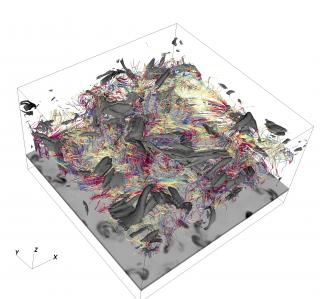Subvenciones relacionadas:
General
La búsqueda de vida en el Universo se ha visto impulsada por los recientes descubrimientos de planetas alrededor de otras estrellas (los llamados exoplanetas), convirtiéndose en uno de los campos más activos dentro de la Astrofísica moderna. En los últimos años los descubrimientos cada vez más numerosos de nuevos exoplanetas y los últimos avances en el estudio de sus atmósferas no sólo están dándonos valiosa nueva información sobre sus propiedades físicas, sino que nos están permitiendo además poner las propiedades de los planetas de nuestro Sistema Solar dentro un contexto más global. El campo esta acercándose al importante descubrimiento de los primeros planetas potencialmente habitables, impulsando estudios más detallados de estos planetas. Con el lanzamiento de las nuevas misiones como JWST, CHEOPS, TESS, ARIEL o PLATO, al campo de exoplanetas se le plantea un futuro muy excitante.
Es por esta razon que este campo se ayuda de y, a su vez motiva, el desarrollo de instrumentación cada vez más sensible y estable tanto para telescopios de tierra como para las misiones espaciales. Dos frentes para los que nuestro grupo esta especialmente preparado. Por un lado, durante los ultimos años hemos desarrollado tecnicas de observacion y reduccion de transitos de exoplanetas para los telescopios del ORM, siendo el nuestro uno de los grupos mas productivos en la explotacion de GTC. Por otro lado, todas las misiones espaciales ESA (presentes y futuras) relacionadas con exoplanetas cuentan con uno o varios de los componentes del proyecto como CoIs.
En el marco de este proyecto, pretendemos que los investigadores del IAC mantengan una situación aventajada con la explotación de OSIRIS y EMIR, instrumentos de primera luz de GTC, y participen en la construcción, comisionado y operación de nuevos instrumentos, como el espectrografo óptico de alta resolución HORUS en el GTC. La explotacion de la fotometria y espectroscopia de transitos con LIRIS en el WHT es tambien uno de nuestros principales intereses, especialmente en preparacion de la instalacion en 2015 del instrumento EMIR en el GTC.
En resumen, el proyecto "Exoplanetas y Astrobiologia" se centrará entorno a estas cuatro lineas principales de actuacion:
1) Caracterización de las propiedades fisicas y atmosfericas de exoplanetas (GTC, WHT, HARPSN, CARMENES, ESPRESSO, ARIEL etc.)
2) Búsquedas y confirmacion de exoplanetas por transitos (CoRoT, Kepler, K2, CHEOPS, XO, LCOGT, WFC, PLATO, etc.)
3) Busquedas/ confirmacion de exoplanetas por velocidad radial (HARPSN, HORUS, LCOGT, SONG, CARMENES)
4) Astrobiología
Miembros
Resultados
- Deteccion de He en la atmosfera de un exoplaneta por primera vez, publicado en Science.
- Deteccion de un planeta entorno a la estrella de Barnard, publicado en Nature
- Deteccion de los primeros planetas del la mision TESS, con varios articulos de impacto
- Descubrimiento de rasgos de Na y Halpha en el espectro de KELT-20b con el TNG
- Publicación del Handbook of Exoplanets, la obra de referencia más extenso en el campo de los exoplanetas. Este Manual fue editado por miembros de nuestro grupo e incluye contribuciones de unos 300 expertos en todo el mundo, incluidos 12 miembros de IAC.
Actividad científica
Publicaciones relacionadas
-
CARMENES input catalogue of M dwarfs. IV. New rotation periods from photometric time seriesAims: The main goal of this work is to measure rotation periods of the M-type dwarf stars being observed by the CARMENES exoplanet survey to help distinguish radial-velocity signals produced by magnetic activity from those produced by exoplanets. Rotation periods are also fundamental for a detailed study of the relation between activity andDíez Alonso, E. et al.
Fecha de publicación:
12019 -
A Second Terrestrial Planet Orbiting the Nearby M Dwarf LHS 1140LHS 1140 is a nearby mid-M dwarf known to host a temperate rocky super-Earth (LHS 1140 b) on a 24.737-day orbit. Based on photometric observations by MEarth and Spitzer as well as Doppler spectroscopy from the High Accuracy Radial velocity Planet Searcher, we report the discovery of an additional transiting rocky companion (LHS 1140 c) with a massMent, K. et al.
Fecha de publicación:
12019 -
K2-140b and K2-180b - Characterization of a hot Jupiter and a mini-Neptune from the K2 missionWe report the independent discovery and characterization of two K2 planets: K2-180b, a mini-Neptune-sized planet in an 8.9-d orbit transiting a V = 12.6 mag, metal-poor ([Fe/H] = -0.65 ± 0.10) K2V star in K2 campaign 5; K2-140b, a transiting hot Jupiter in a 6.6-d orbit around a V = 12.6 mag G6V ([Fe/H] = + 0.10 ± 0.10) star in K2 campaign 10. OurKorth, J. et al.
Fecha de publicación:
12019 -
Machine-learning approaches to exoplanet transit detection and candidate validation in wide-field ground-based surveysSince the start of the Wide-angle Search for Planets (WASP) program, more than 160 transiting exoplanets have been discovered in the WASP data. In the past, possible transit-like events identified by the WASP pipeline have been vetted by human inspection to eliminate false alarms and obvious false positives. The goal of this paper is to assess theSchanche, N. et al.
Fecha de publicación:
32019 -
K2-264: a transiting multiplanet system in the Praesepe open clusterPlanet host stars with well-constrained ages provide a rare window to the time domain of planet formation and evolution. The NASA K2 mission has enabled the discovery of the vast majority of known planets transiting stars in clusters, providing a valuable sample of planets with known ages and radii. We present the discovery of two planetsKuzuhara, Masayuki et al.
Fecha de publicación:
32019 -
Time-resolved image polarimetry of TRAPPIST-1 during planetary transitsWe obtained linear polarization photometry (J-band) and low-resolution spectroscopy (ZJ-bands) of TRAPPIST-1, which is a planetary system formed by an M8-type low-mass star and seven temperate, Earth-sized planets. The photopolarimetric monitoring campaign covered 6.5 h of continuous observations including one full transit of planet TRAPPIST-1d andZapatero Osorio, M. R. et al.
Fecha de publicación:
32019 -
Detection of He I λ10830 Å absorption on HD 189733 b with CARMENES high-resolution transmission spectroscopyWe present three transit observations of HD 189733 b obtained with the high-resolution spectrograph CARMENES at Calar Alto. A strong absorption signal is detected in the near-infrared He I triplet at 10830 Å in all three transits. During mid-transit, the mean absorption level is 0.88 ± 0.04% measured in a ±10 km s-1 range at a net blueshift of - 3Salz, M. et al.
Fecha de publicación:
122018 -
Exploring the substellar population in the Hyades open clusterAims: Our aim is to identify substellar members of the nearby Hyades open star cluster to determine the photometric and spectroscopic properties of brown dwarfs at moderately old ages and extend our knowledge of the substellar mass function of the cluster. Methods: We cross-matched the 2MASS and WISE public catalogues and measured proper motions toPérez-Garrido, A. et al.
Fecha de publicación:
122018 -
The CARMENES search for exoplanets around M dwarfs. The warm super-Earths in twin orbits around the mid-type M dwarfs Ross 1020 (GJ 3779) and LP 819-052 (GJ 1265)We announce the discovery of two planetary companions orbiting around the low-mass stars Ross 1020 (GJ 3779, M4.0V) and LP 819-052 (GJ 1265, M4.5V). The discovery is based on the analysis of CARMENES radial velocity (RV) observations in the visual channel as part of its survey for exoplanets around M dwarfs. In the case of GJ 1265, CARMENESLuque, R. et al.
Fecha de publicación:
122018 -
Ground-based detection of an extended helium atmosphere in the Saturn-mass exoplanet WASP-69bHot gas giant exoplanets can lose part of their atmosphere due to strong stellar irradiation, and these losses can affect their physical and chemical evolution. Studies of atmospheric escape from exoplanets have mostly relied on space-based observations of the hydrogen Lyman-α line in the far ultraviolet region, which is strongly affected byNortmann, L. et al.
Fecha de publicación:
122018 -
Characterization of Exoplanets: Secondary EclipsesWhen an exoplanet passes behind its host star, we can measure the time of the occultation, its depth, and its color. In this chapter we describe how these observables can be used to deduce physical characteristics of the planet such as its averaged dayside emission, departures from uniform disk illumination, or a precise measurement of the orbitalAlonso, Roi
Fecha de publicación:
2018 -
The Solar System as a Benchmark for Exoplanet Systems InterpretationFor hundreds of years, the Solar System and its planetary bodies were the only example in which to base our models of planet formation and evolution. With the discovery of exoplanets, a much greater diversity of planetary types and system architectures have been uncovered. Nevertheless, the Solar System planets remain our best test bed toMontañés-Rodríguez, Pilar et al.
Fecha de publicación:
2018 -
The Detectability of Earth's Biosignatures Across TimeOver the past two decades, enormous advances in the detection of exoplanets have taken place. Currently, we have discovered hundreds of Earth-sized planets, several of them within the habitable zone of their star. In the coming years, the efforts will concentrate in the characterization of these planets and their atmospheres to try to detect thePallé, Enric
Fecha de publicación:
2018 -
Transit Photometry as an Exoplanet Discovery MethodPhotometry with the transit method has arguably been the most successful exoplanet discovery method to date. A short overview about the rise of that method to its present status is given. The method's strength is the rich set of parameters that can be obtained from transiting planets, in particular in combination with radial velocity observationsDeeg, Hans J. et al.
Fecha de publicación:
2018 -
Small Telescope Exoplanet Transit Surveys: XOThe XO project aims at detecting transiting exoplanets around bright stars from the ground using small telescopes. The original configuration of XO (McCullough et al. 2005) has been changed and extended as described here. The instrumental setup consists of three identical units located at different sites, each composed of two lenses equipped withCrouzet, N.
Fecha de publicación:
2018 -
Bayesian Methods for Exoplanet ScienceExoplanet research is carried out at the limits of the capabilities of current telescopes and instruments. The studied signals are weak and often embedded in complex systematics from instrumental, telluric, and astrophysical sources. Combining repeated observations of periodic events, simultaneous observations with multiple telescopes, differentParviainen, H.
Fecha de publicación:
2018 -
Metal-Depleted Brown DwarfsThis chapter reviews our current knowledge of metal-poor ultracool dwarfs with spectral types later than M7. The current census of M, L, and T subdwarfs is explored. The main color trends of subdwarfs from the optical to the mid-infrared are described and their spectral features presented, which led to a preliminary and tentative spectralLodieu, N.
Fecha de publicación:
2018 -
Planets, candidates, and binaries from the CoRoT/Exoplanet programme. The CoRoT transit catalogueThe CoRoT space mission observed 163 665 stars over 26 stellar fields in the faint star channel. The exoplanet teams detected a total of 4123 transit-like features in the 177 454 light curves. We present the complete re-analysis of all these detections carried out with the same softwares so that to ensure their homogeneous analysis. Although theDeleuil, M. et al.
Fecha de publicación:
112018 -
Brown dwarf companion with a period of 4.6 yr interacting with the hot Jupiter CoRoT-20 bWe report the discovery of an additional substellar companion in the CoRoT-20 system based on six years of HARPS and SOPHIE radial velocity follow-up. CoRoT-20 c has a minimum mass of 17 ± 1 MJup and orbits the host star in 4.59 ± 0.05 yr, with an orbital eccentricity of 0.60 ± 0.03. This is the first identified system with an eccentric hot JupiterRey, J. et al.
Fecha de publicación:
112018 -
Four winters of photometry with ASTEP South at Dome C, AntarcticaContext. Dome C in Antarctica is a promising site for photometric observations thanks to the continuous night during the Antarctic winter and favorable weather conditions. Aims.We developed instruments to assess the quality of this site for photometry in the visible and to detect and characterize variable objects through the Antarctic Search forCrouzet, N. et al.
Fecha de publicación:
112018



